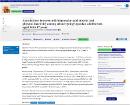| dc.contributor.author | James, Mugisha | |
| dc.contributor.author | Tine, Van Damme | |
| dc.contributor.author | Davy, Vancampfort | |
| dc.date.accessioned | 2024-04-22T08:26:25Z | |
| dc.date.available | 2024-04-22T08:26:25Z | |
| dc.date.issued | 2024-04 | |
| dc.identifier.citation | Mugisha, J., Van Damme, T., & Vancampfort, D. (2024). Associations between mild depression and anxiety and physical inactivity among school-going Ugandan adolescents aged 14 to 17 years. Journal of Child & Adolescent Mental Health, 1-11. | en_US |
| dc.identifier.uri | https://doi.org/10.2989/17280583.2023.2288969 | |
| dc.identifier.uri | https://hdl.handle.net/20.500.12504/1672 | |
| dc.description.abstract | Objective: The aim of this cross-sectional study was to investigate associations between physical activity levels and emotional and behavioural problems in school-going adolescents aged 14 to 17 years in Uganda.
Methods: Two-hundred and five adolescents [median (interquartile range) age = 16.0 (1.0) years; female = 61.9%] completed the interviewer-administered Strengths and Difficulties Questionnaire (SDQ), Patient Health Questionnaire-9 (PHQ-9), the Generalised Anxiety Disorder-7 questionnaire (GAD-7), and the Physical Activity Vital Sign (PAVS) measure. Spearman’s rho correlations and Mann–Whitney U-tests were applied.
Results: Among 205 adolescents, 97.1% were physically inactive (PAVS < 420min/week), while 64.4% reported either mild depressive (PHQ-9 ≥ 5) or anxiety (GAD-7 ≥ 5) symptoms. Higher PAVS scores correlated significantly with lower SDQ emotional problems (ρ = −0.23, p < 0.001), lower PHQ-9 (ρ = −0.26, p < 0.001), and lower GAD-7 (ρ = −0.22, p < 0.001) scores. Those with emotional problems (SDQ ≥ 5) (n = 86) were significantly less physically active than those without (n = 119) [30.0 (62.5) versus 60.0 (105.0) min/week, p < 0.001]. Those with depressive symptoms (PHQ-9 ≥ 5) were significantly less physically active than those without [35.0 (70.0) versus 60.0 (120.0) min/week, p < 0.001].
Conclusion: Physical inactivity and mental health problems are related important public health concerns in school-going adolescents in low-income countries such as Uganda. The efficacy and effectiveness of school-based mental health literacy programs, including physical activity promotion, should be explored in these low-resource settings. | en_US |
| dc.language.iso | en | en_US |
| dc.publisher | Journal of Child & Adolescent Mental Health | en_US |
| dc.subject | Adolescence | en_US |
| dc.subject | Metal health | en_US |
| dc.subject | Physical Activity | en_US |
| dc.title | Associations between mild depression and anxiety and physical inactivity among school-going Ugandan adolescents aged 14 to 17 years | en_US |
| dc.type | Article | en_US |

